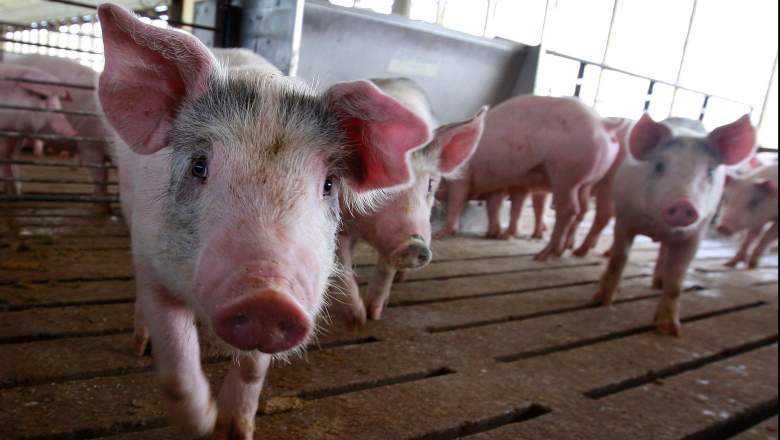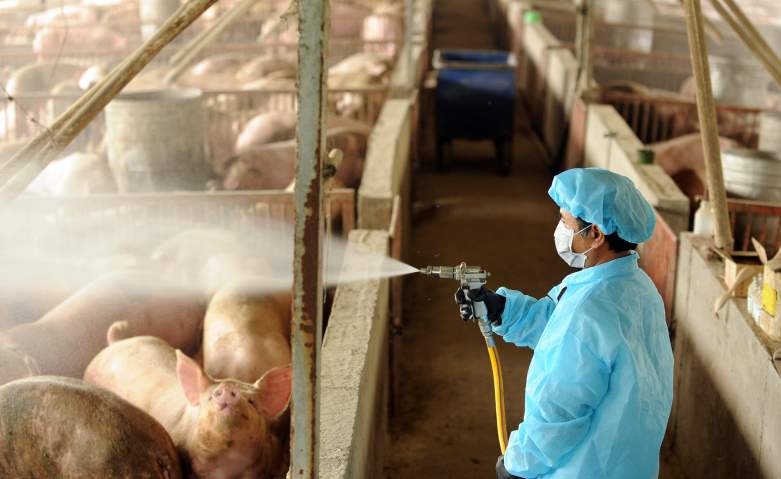
A newly discovered Swine flu with the potential to be a pandemic has been discovered in pigs in China, according to researchers. In a paper published by the National Academy of the Sciences, they wrote the virus with a G4 genotype has “all the essential hallmarks of a candidate pandemic virus.”
According to the paper, “pigs are intermediate hosts for the generation of pandemic influenza virus,” so regularly testing them for flu viruses is a way to stay ahead of the next “emergence of the next pandemic influenza.”
The paper’s authors say they discovered a swine flu similar to the one that caused a 2009 pandemic and it has been in the pig population in China since 2016. The worry is that the virus will jump from pigs to humans, and then humans will transfer it to one another, much like the world is currently grappling with regarding the spread of COVID-19.
10% of Swine Workers Tested Had the Swine Flu

GettyA member of the government’s animal disease department works to disinfect a pig farm as a precaution in Hsichiou, Changhua county, in central Taiwan on April 27, 2009.
The new strain that is very similar to the 2009 version is called Eurasian avian-like (EA) H1N1 virus. Scientists in the study are saying a couple of concerning things about their new discovery, but others independently say the chance for the new strain to become a pandemic is low. More on that in a moment.
Let’s start with the researchers. They found that for the strain of virus they discovered, G4, there is no “preexisting population immunity protection.”
What’s more, about 10% of swine workers tested had the virus. Specifically, they tested 338 people who work closely with the pigs, and of those, 35 had contracted the virus, mostly in the age ranges of 18 to 35. The study does not say whether they did contact tracing to see if the virus had spread beyond those workers.
The researchers say their testing also showed them that the “virus has acquired increased human infectivity,” and that “such infectivity greatly enhances the opportunity for virus adaptation in humans and raises concerns for the possible generation of pandemic viruses.”
They recommend that the workers are closely monitored along with the pig population. According to Statista, China is home to the world’s largest population of domestic pigs, with 310.41 million as of April 2020.
Other Scientists Says This Particular Swine Flu Is Not a Definite Imminent Threat but It’s Worth Keeping an Eye On Because Another Flu Pandemic Is Inevitable
Carl Bergstrom, a biologist at the University of Washington tweeted his breakdown of the study and said, “There’s no evidence that G4 is circulating in humans, despite five years of extensive exposure. That’s the key context to keep in mind. What the paper does do is something important for the epidemiological community: it points to a virus that we need to be keeping a careful eye on.”
Bergstrom said people are “not imminently” looking at a double pandemic, and that it will be important to screen, especially if “clusters of illness emerge in swine workers.”
Dr. Angela Rasmussen, a Virologist at Columbia University also weighed in with her take on the paper. She, like Bergstrom, wrote a long Twitter thread saying that while the findings are seemingly all well and good, there is no proof that the newly discovered swine flu is harmful to humans in a meaningful way.
Rasmussen wrote:
This is where “pandemic potential” needs to emphasize the “potential” part. Yes, this virus could evolve the ability to be an efficiently transmitted human-to-human pathogen…So the bottom line is that our understanding of what is a potential pandemic influenza strain is limited. Sure, this virus meets a lot of the basic criteria but it’s not for sure going to cause a hypothetical 2020 flu pandemic, or even be a dominant strain in humans. We need to keep an eye on it but we should not focus on any one virus exclusively. We should prepare for ANY kind of emerging influenza pandemic. What we should NOT do is freak out and expect that another flu pandemic is imminent. We should prepare for the flu pandemic that will come: maybe this fall, maybe not for another few years, but is inevitable.
READ NEXT: Masks Should Be Worn by Everyone Except These Groups: New CDC Guidance